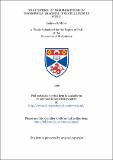Files in this item
The control of morphogenesis in 'Drosophila' imaginal disc cell lines 'in vitro'
Item metadata
| dc.contributor.advisor | Milner, Martin | |
| dc.contributor.author | Miller, Andrew S. | |
| dc.coverage.spatial | 272 p. | en_US |
| dc.date.accessioned | 2018-06-13T15:25:07Z | |
| dc.date.available | 2018-06-13T15:25:07Z | |
| dc.date.issued | 1996 | |
| dc.identifier.uri | https://hdl.handle.net/10023/14026 | |
| dc.description.abstract | The experimental component of this thesis represents the continuation of studies carried out in the Milner laboratory to characterise the biology of Drosophila imaginal disc cell lines growing in vitro. The bulk of this study was concerned with the morphological and molecular characterisation of imaginal cell interactions in vitro and contrasting this with what is known of imaginal cell biology in vivo. The imaginal cell lines were thus seen as both an amenable model for the detailed analysis of a cells interaction with its environment and, more broadly, as an assessment of the effects of isolating and maintaining animal cells in vitro. The reaggregation of single imaginal cells when in suspension is rapid and extensive when in the presence of the divalent cations, Ca2+ and Mg2+, but is not entirely dependent on them suggesting the existence of separate systems of adhesion and the presence of a variety of cell adhesion molecules (CAMs). During the course of growth in vitro there appears to be a shift in strategy between cell-substrate and cell-cell adhesion as cells move from monolayers into aggregates. A new set of leg cell lines were cloned, some of which had a radically reduced capacity to reaggregate in suspension suggesting that CAMs can be selectively lost from the imaginal cell surface. PS integrins are widely expressed in imaginal cells in vitro, as in vivo, and seem to be similarly involved in various cell adhesion events here. PS integrins are expressed at all stages of imaginal cell growth and function both in mediating cell-substrate adhesion, notably to human fibronectin, and in cell-cell adhesion. PS integrins appear to mediate a 'higher order' cell-cell adhesion via an unidentified component of the extracellular matrix (ECM) which again can be substituted using vertebrate molecules. PS integrins may direct aggregation by forming tension transmitting junctions with other cells, evidence for which is provided by F-actin and tubulin expression in aggregating cells. The in vivo epithelial phenotype, characterised by apical-basal polarity, can be re-established in part by growing cells on fibronectin-coated membranes in the presence of unidirectional nutrient uptake and a feeder layer of cells. Cells in vitro lack such polarity signified by the absence of specialised intercellular junctions and a loss of restriction of expression of the putative CAM and signalling molecule, CRUMBS. Another CAM which appears to be expressed during imaginal cell growth in vitro is the immunoglobulin, fasciclin III, or a variant, which is restricted in expression to single migratory cells and during cell-cell adhesion. Some evidence is also provided that these cell lines express, and can endocytose, proteins known as larval serum proteins'. The nature of this uptake remains obscure, but does not seem to be enhanced by the presence of the moulting hormone, 20-hydroxyecdysone (20-HE). | en_US |
| dc.language.iso | en | en_US |
| dc.publisher | University of St Andrews | |
| dc.subject.lcc | QH605.2M5 | en |
| dc.subject.lcsh | Mitosis | en |
| dc.title | The control of morphogenesis in 'Drosophila' imaginal disc cell lines 'in vitro' | en_US |
| dc.type | Thesis | en_US |
| dc.type.qualificationlevel | Doctoral | en_US |
| dc.type.qualificationname | PhD Doctor of Philosophy | en_US |
| dc.publisher.institution | The University of St Andrews | en_US |
This item appears in the following Collection(s)
Items in the St Andrews Research Repository are protected by copyright, with all rights reserved, unless otherwise indicated.

